“Campeones, campeones, campeones!”, were the chants of around 90,000 people inside the Camp Nou as Lionel Messi basically passed the ball into the net behind Jan Oblak, making it a two-nil victory for Barcelona over Atlético Madrid. And just like that, the door is slammed shut for Diego Simeone as his team plunges to an 11-point deficit in La Liga, having experienced yet another loss against the Catalans.
And the Argentine coach is no stranger to those. In his 15 attempts so far in his career, Simeone has never beaten Barcelona in the domestic league. But nothing is mathematically over just yet, and even with this defeat this late in the campaign, Atlético Madrid can still hope for a miraculous comeback.
This tactical analysis will use statistics to determine how the resilient away troops almost weathered the storm in Catalunya, only to fall short to some late-game magic by Barcelona’s finest.
Lineups
Barcelona (4-3-3)
Starting XI: Ter Stegen – Sergi, Piqué, Lenglet, Alba – Rakitić, Busquets, Arthur – Messi, Suárez, Coutinho
Bench: Cillessen, Murillo, Semedo, Umtiti, Aleñá, Boateng, Malcom
Coach: Ernesto Valverde
Atlético Madrid (4-4-2)
Starting XI: Oblak – Arias, Giménez, Godín, Filipe Luís – Koke, Thomas, Rodrigo, Saúl – Costa, Griezmann
Bench: Adán, Juanfran, Savić, Vitolo, Correa, Kalinić, Morata
Coach: Diego Simeone
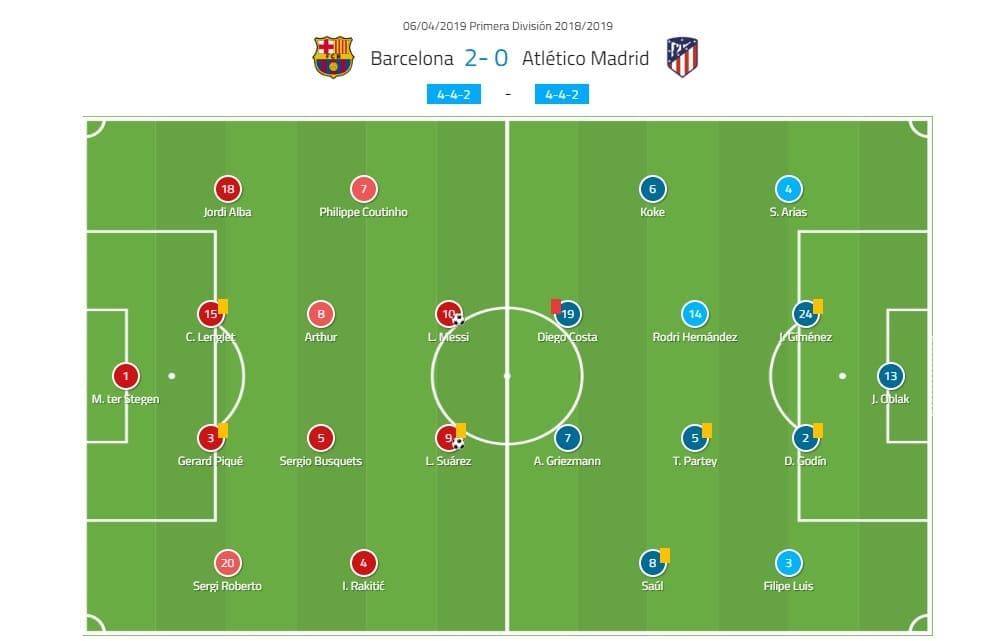
Barcelona’s setup
There were some initial reports saying that Ernesto Valverde could prioritise the Champions League clash against Manchester United so much, that he might sacrifice this potential title-winning match at the Camp Nou. Suffice it to say that no such thing happened this Saturday evening.
Barcelona very much fielded their strongest XI in their usual formation. We wondered whether Valverde would go down the more defensive-minded or the offensive-minded route and he ended up choosing the latter option. Philippe Coutinho was chosen as the third man up front with Luis Suárez and Lionel Messi, while Sergi Roberto got the nod in front of Nélson Semedo.
The Catalans operated in a 4-4-2 system (which looked more like a 4-3-3 on the pitch) that saw little to no changes throughout the game, as did their default choice of personnel across the rest of the pitch.
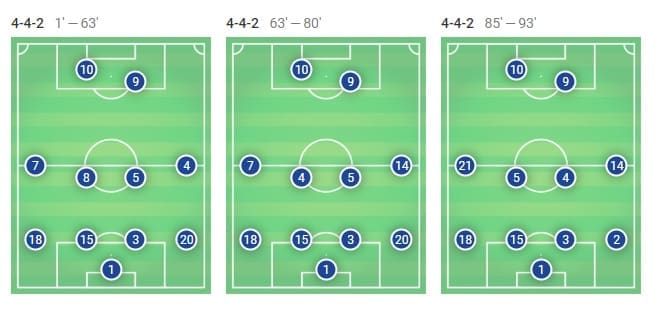
Atlético Madrid’s setup
There has been some trouble in paradise for Diego Simeone these past few weeks due to some injury concerns with many of his men. Before he actually arrived at the Camp Nou, the Argentine was supposedly without four players, two of whom were Álvaro Morata and Diego Costa. Still, things took a slight turn for the better as both of the forwards found themselves on the bus for Catalunya.
With that in mind, Diego Costa assumed his position next to Antoine Griezmann in attack and Morata was benched. There was also a slight dilemma concerning the back four of Atlético Madrid but that was also solved pretty quickly.
Arias did indeed start over Juanfran, and as expected, he formed a quartet with Giménez, Godín and Filipe Luís. Atlético Madrid were deployed in their standard and preferred 4-4-2 formation that had to be somewhat altered due to Diego Costa’s red card in the first half. From that moment onward, the Rojiblancos played in a 4-4-1/ 4-3-2 formation, still putting some preference to the attacking side of things.
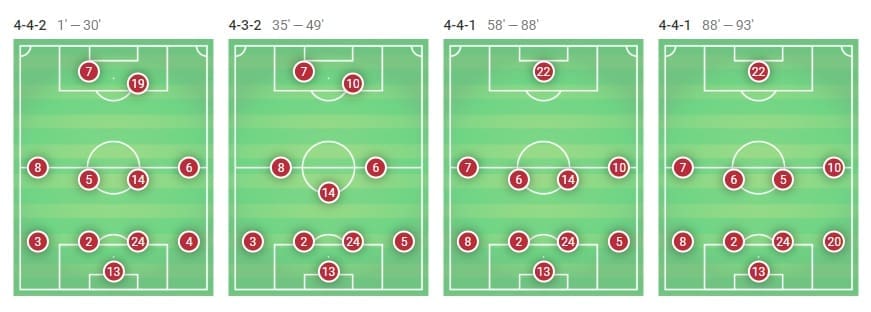
Atlético Madrid’s defensive solidity
Even before the game started we knew some things for certain. Barcelona would most likely dominate the game and the possession while Atlético Madrid would surrender the ball and sit back and wait for their golden opportunity, whenever it might arrive. And this came into fruition to the fullest, as predicted.
Diego Simeone deployed his two banks of four and opted to stay as narrow and as compact as possible to deflect all of Barcelona’s attempts at penetration. Another thing that was extremely important in this regard was to keep the Catalans’ midfield at bay at all times. This was done by simply achieving a numerical superiority in the middle of the park.
Atlético Madrid didn’t really press Barcelona high up the pitch at all times but rather set up a mid-block, pushing their defensive and midfield lines just enough to entrap the home team’s forwards and midfielders between two extremely compact lines of players.
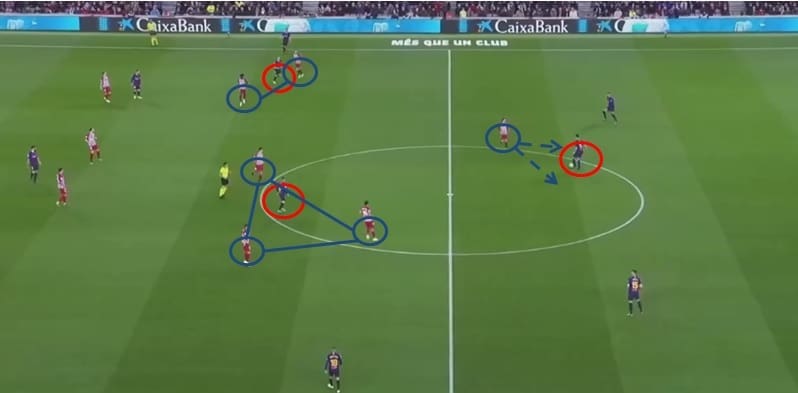
Notice in the image above how this tactic translated onto the pitch. In the preview, we mentioned how Sergio Busquets would assume the lavolpiana position between the centre-backs while two other midfielders would go further up the pitch. This actually worked extremely well for Atlético Madrid because one of their forwards could press the backline while the other would help man-mark the others in midfield.
Both Ivan Rakitić to the right and the more centrally positioned Arthur Melo were very well covered by multiple defenders. There was no easy way to get the ball moving through the middle of the pitch as all the passing channels were closed shut.
The other problem facing Barcelona had its roots in the lineup itself. With their front trio consisting of Philippe Coutinho, Lionel Messi and Luis Suárez respectively, Barcelona had a lot of attacking talent but they were sorely lacking one thing: width. When facing a team so defensively solid and so compact, the key is to stretch them in order to create space.
With no natural wingers on the pitch, Barcelona’s only source of width were the full-backs, in this case, Jordi Alba and Sergi Roberto. But Atlético Madrid already knew that and came prepared. Covering wide areas is something they excel at and they did show it for the majority of the game.
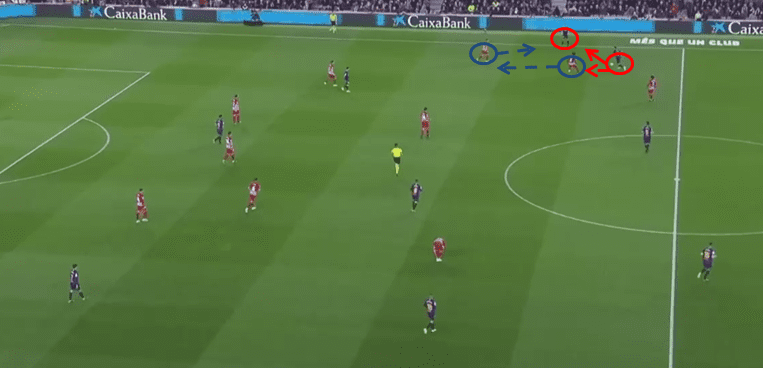
In the image above, Ivan Rakitić and Sergi Roberto try to create something on the right flank but notice how Atlético Madrid’s midfield work well to cover the entrance to the wide area. Thomas Partey drops deeper, following Rakitić closely while the other player stays close to Roberto in case the Spaniard tries sending a through ball despite his teammate also being marked.
This meant that in order to get past this block, Barcelona would have to get creative and solve the puzzle differently. Partey was a huge piece in Simeone’s jigsaw and a big reason the fortress was still in one piece after the first 45 minutes.
He recorded four tackles, three ball recoveries, one interception and 100% take-ons completed. Defensively, he provided in the most crucial areas when blocking overlaps and Barcelona’s entrances to the wide areas, but was also a threat going forward, marking the transitions with either his passes (90% completed in the first half) or pace and progressing the ball well.
Barcelona react and play to their strengths
We already mentioned how Barcelona’s lineup limited them in many ways due to stripping all the width from them but Ernesto Valverde knew what he was doing. Playing Philippe Coutinho from the get-go instead of Malcom or even Semedo in a 4-4-2 meant that he was going for that midfield penetration and technicality in order to sustain the possession dominance.
In the preview, it was also stated that if Coutinho indeed did get a chance to start such a big game, his dialogue with Jordi Alba would be key to Barcelona successfully utilising their left flank. The Brazilian had a good game in general but what stood out the most was how he managed to free Alba and allow him to make darting runs in behind Atlético Madrid’s defence.
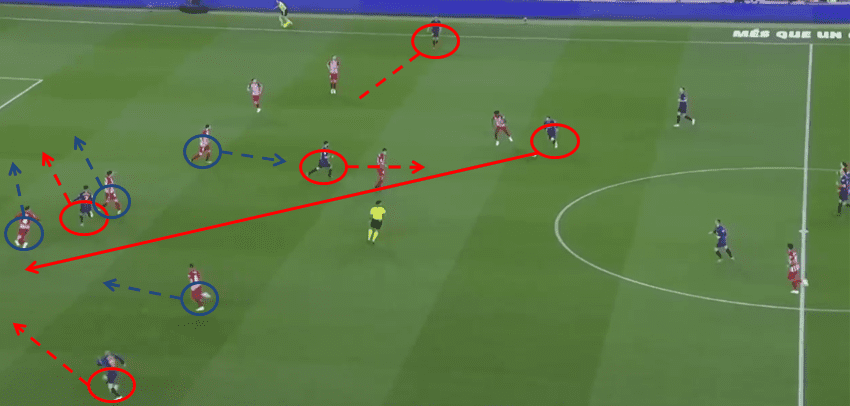
There are a couple of things to notice in the example above. Knowing that penetrating through the middle would be extremely difficult and also keeping in mind that they don’t have any real wide players on the pitch, Barcelona had to adapt and create space through different means.
Firstly, Sergi Roberto does his part of the job by staying relatively high up and hugging the very edge of the pitch, attracting markers and stretching the backline of the defending team. Secondly, Philippe Coutinho cuts inside to his right, entering his preferred half-space, and leaving the whole flank for Alba to exploit.
Not only that, but the Brazilian also drags multiple defenders with him. This basically leaves Alba in a one-on-one foot race, which is undoubtedly a situation the Spaniard loves to find himself in.
Luis Suárez also drops deeper to midfield, making the back four tuck inside even more, and move away from the flank that Barcelona will soon target. In this case, Atlético’s tendency to stay narrow played right into Barcelona’s hands.
All that was left was to activate that all too familiar Messi-Alba connection and you had a recipe for success. The Argentine sent a beautiful long ball over Atlético Madrid’s defence and put Alba eye to eye with Jan Oblak. Unfortunately for Barcelona, even though Alba beat the Slovenian keeper, the post kept the Rojiblancos’ net safe.
Other than that clear chance, the Catalans managed to create a handful of others but most hit Atlético Madrid’s wall between the sticks. Interestingly enough, most of those chances arose as a direct result of Atlético being out of their compact shape. Through-balls and line-breaking passes are definitely one of Barcelona’s biggest weapons but since their were so good at closing down channels, they had to find ways to open them.
Position swapping and space manipulation were two of those ways, as we saw in the example with Jordi Alba, but another was forcing Atlético Madrid to break their formation. Simeone’s troops rarely venture all the way up the pitch to contest the ball and for the majority of the game against Barcelona, they completely refrained from doing so. Why? Because the Catalans are extremely good at attracting and dispersing pressure.
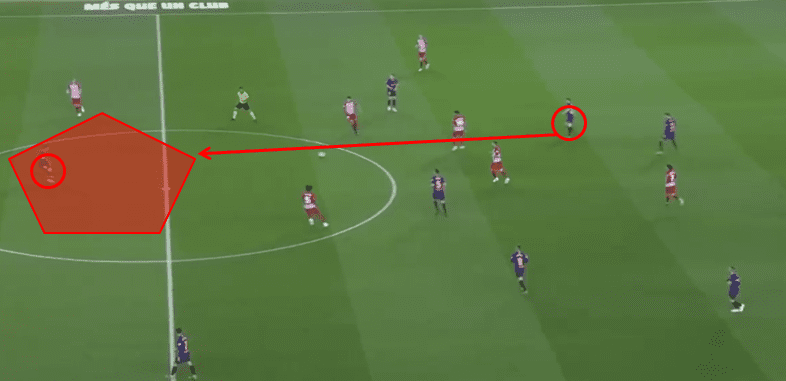
Notice how as soon as Atléti step out to contest the ball, free pockets of space start appearing across the pitch, and suddenly Lionel Messi is unmarked and ready to receive the ball right into his feet. Not all teams could exploit this since it does require players with exceptional passing abilities, but with Barcelona, such chances are almost always taken.
Things took another grim turn for Atlético Madrid once Malcom was introduced, as it meant Barcelona would once again be dangerous down the flanks and the visitors would have to stretch out in order to cover for all the possible entrances into the final third.
The image below shows how the Catalans suddenly had Simeone’s men on strings. Malcom hugs the touchline and goes extremely wide, attracting two markers while Sergi Roberto makes an underlap and sprints into the free space now created with the absence of the two aforementioned defenders.
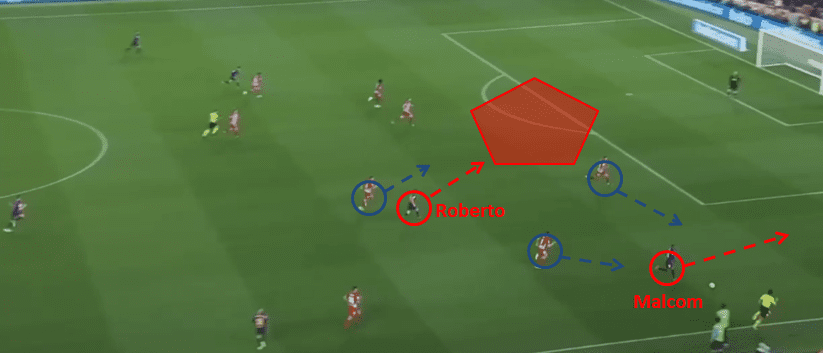
Again, when Barcelona utilised their wings this effectively, Atlético Madrid’s narrow structure suddenly became their weakness instead of a strength. One other thing Malcom’s introduction also made sure of was the fact that some of Messi’s markers had to stay wider in order to cover for the Brazilian, thus leaving Messi that much more free in the process.
Valverde knew what he was doing, and putting Malcom on the right wing was a good call even though Coutinho was subbed off which made for a vacant place on the other side of the pitch. Letting Malcom operate on the right meant that Alba wouldn’t have a natural winger in front of him who would block his overlaps, and Malcom could target a diminished right side of Atlético’s defence and help out Messi as well.
Diego Simeone went all out but was shot in the foot by his own team
Maybe it could be going a bit too far but saying that Diego Costa was one of the main culprits, if not the direct culprit, for Atlético Madrid’s demise is not as far fetched as it may sound at first. The Spaniard’s big mouth turned his yellow card into a red one, and Atlético Madrid were forced to play with 10 men for two-thirds of the game.
Simeone reacted almost immediately, shifting the formation of his team from 4-4-1 to 4-3-2. Interestingly enough, he decided to sacrifice an additional midfielder in order to keep playing with two forwards. This was quite surprising and hinted at a more offensive approach from a traditionally extremely defensive coach.
What was even more surprising were the rest of his substitutes, both of whom were, in fact, of an attacking nature. But, even though the team sheet would say otherwise, the change in personnel did not do much for Atlético Madrid’s attacking prowess. The visitors could not execute any deadly counters since they were pinned down in their own half for the majority of the game, and they also missed an additional link to get their quick transitions going.
For those reasons, they had to rely on set-pieces and beating Barcelona in the air, as was predicted. This was achieved as they did win most of the aerial battles (64.1%), both when defending and attacking, as can be seen below. Much to their disappointment, this was without any palpable results.
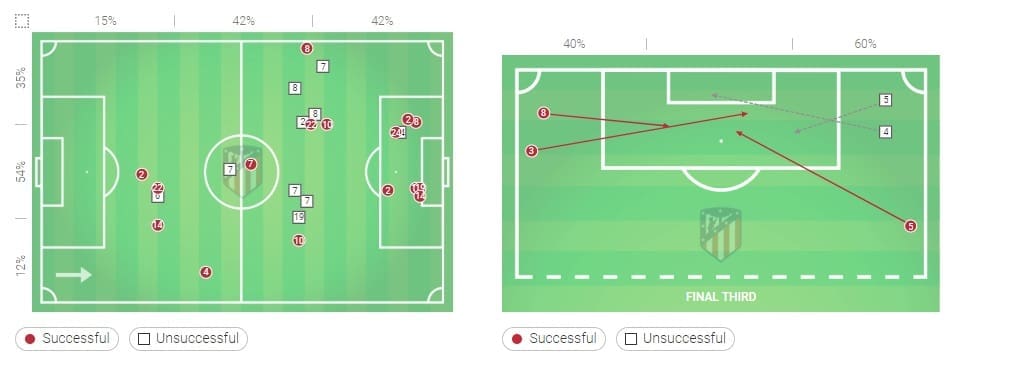
Still, at one point in the game, Simeone’s men had better possession than Barcelona and were creating chances through open play and great sequences of passes. Antoine Griezmann was key in this aspect with his movement, and link-up play from deeper positions and around the edge of the box.
With Rakitić and Busquets covering the right side extremely well, Atlético Madrid recognised their opportunity would be down Barcelona’s left where both Coutinho and Arthur were somewhat less defensively oriented. With Alba spending most of his time overlapping and in the opposition’s half, it made more sense trying to exploit the free space the Spaniard left behind.
Of all Ateltico Madrid’s attacks, 35% came down the right side, 36% went through the middle and only 29% down the left flank. They couldn’t exploit their counter-attacking prowess as much as they would have wanted even though they did provoke losses of possession for their counterparts. Barcelona recorded a total of 81 throughout the game but only three led to direct shots on goal. Griezmann was the main link in Atlético’s transitions.
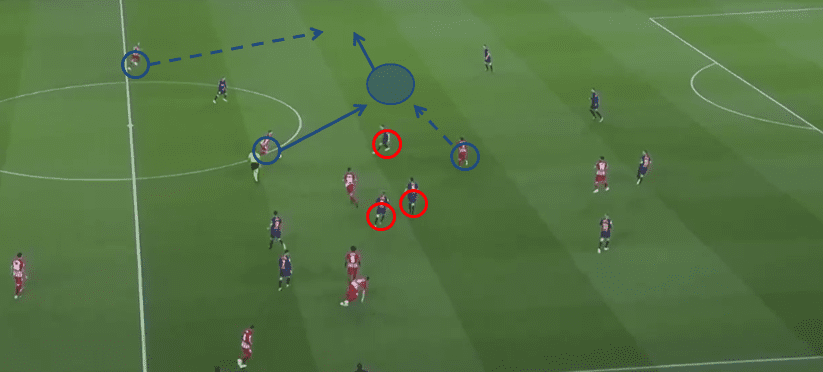
Note in the image above how the Frenchman drops deeper to receive the ball and plays the role of the man between the lines. Once Barcelona commit to their collapsing tactic, space opens up and Griezmann creates a passing channel to exploit with his good movement.
He then recycles the possession down the wings and sets up his team to either cross the ball into the box, which they excel at, or combine even further on the edge of Barcelona’s backyard.
Unfortunately, the Catalans were disciplined in defence as much as they were proficient going the other way, and Atlético failed to take advantage of the few chances they got throughout the game. Their 0.51 xG value compared to Barcelona’s 2.13 tells the right story at the end of the day.
Conclusion
For quite a long stretch of the game, it seemed like Atlético Madrid would, in fact, get at least a point for their valiant efforts. Being a man down was barely noticeable in their overall game plan and its execution. Barcelona were, however, in firm control throughout the whole 90 minutes, and were it not for some extraordinary Jan Oblak saves, the result could have been altered much sooner than it was in reality.
Barcelona now have an 11-point cushion with only seven games to go in La Liga. Mathematically, we cannot call it a wrap just yet, but looking solely at the fixtures ahead and the likelihood of both title contestants slipping up here and there, it’s difficult not to bet on the Catalans.
With that being said, however, football is a funny sport, and predicting it might, more often than not, turn out to be a fool’s errand. Still, as it stands, Barcelona are on course to winning yet another La Liga trophy for their cabinet, their eighth in the last 11 seasons.
If you love tactical analysis, then you’ll love the digital magazines from totalfootballanalysis.com – a guaranteed 100+ pages of pure tactical analysis covering topics from the Premier League, Serie A, La Liga, Bundesliga and many, many more. Pre-order your copy of the April issue for just ₤4.99 here, or even better sign up for a ₤50 annual membership (12 monthly issues plus the annual review) right here.

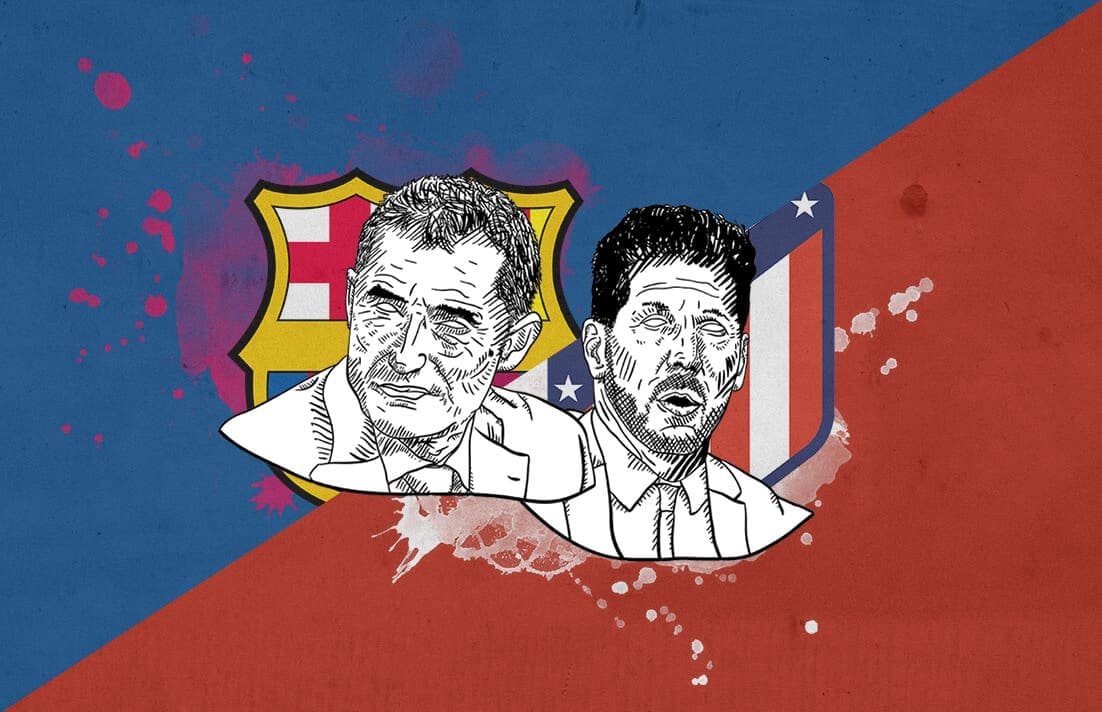




Comments